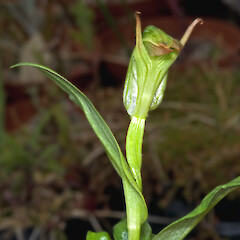Pterostylis silvicultrix
Common name
tutukiwi, Chatham Island greenhood
Synonyms
Pterostylis banksii var. silvicultrix F.Muell.
Family
Orchidaceae
Flora category
Vascular – Native
Endemic taxon
Yes
Endemic genus
No
Endemic family
No
Structural class
Orchids
NVS code
The National Vegetation Survey (NVS) Databank is a physical archive and electronic databank containing records of over 94,000 vegetation survey plots - including data from over 19,000 permanent plots. NVS maintains a standard set of species code abbreviations that correspond to standard scientific plant names from the Ngä Tipu o Aotearoa - New Zealand Plants database.
PTESIL
Chromosome number
2n = 44-46
Current conservation status
The conservation status of all known New Zealand vascular plant taxa at the rank of species and below were reassessed in 2017 using the New Zealand Threat Classification System (NZTCS) – more information about this can be found on the NZTCS website. This report includes a statistical summary and brief notes on changes since 2012 and replaces all previous NZTCS lists for vascular plants.
Please note, threat classifications are often suggested by authors when publications fall between NZTCS assessment periods – an interim threat classification status has not been assessed by the NZTCS panel.
- Conservation status of New Zealand indigenous vascular plants, 2017 . 2018. Peter J. de Lange, Jeremy R. Rolfe, John W. Barkla, Shannel P. Courtney, Paul D. Champion, Leon R. Perrie, Sarah M. Beadel, Kerry A. Ford, Ilse Breitwieser, Ines Schönberger, Rowan Hindmarsh-Walls, Peter B. Heenan and Kate Ladley. Department of Conservation. Source: NZTCS and licensed by DOC for reuse under the Creative Commons Attribution 4.0 International licence.
2017 | At Risk – Naturally Uncommon | Qualifiers: IE
Previous conservation statuses
2012 | At Risk – Naturally Uncommon | Qualifiers: IE
2009 | At Risk – Naturally Uncommon | Qualifiers: IE
2004 | Range Restricted
Distribution
Endemic. New Zealand: Chatham Islands (Rēkohu / Wharekauri / Chatham Island, Rangihaute / Rangiauria / Pitt Island, Maunga’re / Mangere Island, Hokorereoro / Rangatira / South East Island.
Habitat
A widespread species of forests, restiad bog and stream, lake, pond and other wetland margins. Often found as a low epiphyte on tree fern trunks.
Detailed description
Terrestrial tuberous orchid growing in colonies, sometimes found as a low epiphyte perching on the bases of tree fern trunks. Plants dimorphic. Sterile plants 20–150 mm tall; leaves 30–80 × 10–20 mm, light green, elliptical to elliptical-lanceolate, margins entire or rarely minutely sinuate. Flowering plants with 3–6 cauline leaves obliquely erect to spreading; lamina 40–150 × 0.6–22 mm, elliptical to elliptical-ovate to lanceolate, sessile, sheathing at base; margfins entire; apex acute to acuminate. Pedicel 5–30 mm long, stout. Ovary 10–15 mm long, asymmetric, ribbed. Flower solitary, 18–25 mm long, erect, translucent white and green with red brown suffusions toward the tips of the galea and lateral sepals; galea erect and gibbous at base, then curving forwards to the apex. Dorsal sepal slightly longer than the petals, 20–25 × 10–16 mm ovate-lanceolate, expanded in proximal ⅓ then narrowed and tapered to the acute apex. Lateral sepals erect, loosely embracing the galea leaving a narrow lateral gap to the petal margins, upper part of sinus curved when viewed from the side, sloping to a broad V when viewed from the front; conjoined part 10–15 mm long, 8–10 mm at the top, narrowed to 3 mm wide at the base, the margins inrolled, tapered towards the free points; free points 8–10 mm long curved forwards, tips equal to or protruding slightly above the galea (often curled forward). Petals 25–30 × 4–6 mm, obliquely oblong-lanceolate, falcate, acute, green with a narrow white central area towards the base, the apex reddish-brown; flange vestigial. Labellum erect, curved forward distally,the apex prominent through the sinus in the set position; labellum hinge ligulate 3 × 1 mm; lamina 12–14 mm, green narrow-obovate, callus 0.5–0.7 mm reddish green, raised; appendange 2 mm, decruved, apex penicillate. Column 15 mm, green and white, column foot 4 mm, wings 7 mm; basal lobes 3 × 1 mm, apex obtuse,inner margins incruved, sparsely ciliate; mid-section 3 mm, green; apical lobe 1 mm. Stigma 5 × 1.5–2 mm, elliptic scutiform, medial on the column to edges, raised. Rostellum 0.5 mm diameter, brownish, below anther and high up above stigma and connected to it by a narrow groove. Capsule 25–30 × 6–8 mm, initially green to brown, narrowly obovoid, peduncle up to 50 mm long.
Manaaki Whenua Online Interactive Key
Similar taxa
Distinguished from other indigenous Pterostylis R.Br. species by the relatively short, broad, suberect to erect, ovate to lanceolate leaves, the upper most overtopping the solitary green and white striped flower whose sepals and petals are characteristically orange-tipped. The lateral sepals are distinctive in that they curl forward while the dorsal sepals only just exceed the petals and are often curved upwards. On the Chathams P. silvicultrix has often been confused with P. banksii A.Cunn., which though highly variable is, on the Chathams at least, a much smaller plant whose uppermost leaves overtop the flower and whose flower is more darkly green-striped, and without any orange colouration.
Flowering
November–December
Flower colours
Green, White
Fruiting
Late summer
Propagation technique
Difficult—should not be removed from the wild.
Threats
Although very common in suitable habitat it cannot be denied that forest clearance has decreased the available habitat for this species. Cattle, sheep, pigs and weka browse, trample and—weka especially—uproot the tubers.
Etymology
pterostylis: Winged column
Where To Buy
Not commercially available
Attribution
Fact Sheet prepared for NZPCN by P.J. de Lange 14 April 2007: Description and recognition notes are based on information and details kindly provided by Dr B.P.J. Molloy supplemented with observations made from fresh material collected from the Chatham Islands.
NZPCN Fact Sheet citation
Please cite as: de Lange, P.J. (Year at time of access): Pterostylis silvicultrix Fact Sheet (content continuously updated). New Zealand Plant Conservation Network. https://www.nzpcn.org.nz/flora/species/pterostylis-silvicultrix/ (Date website was queried)





